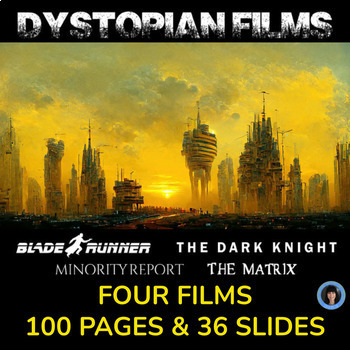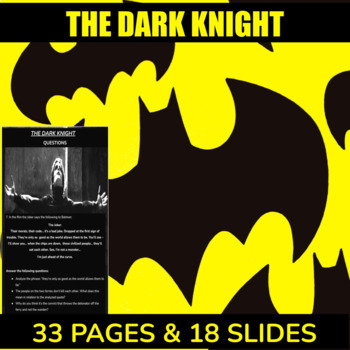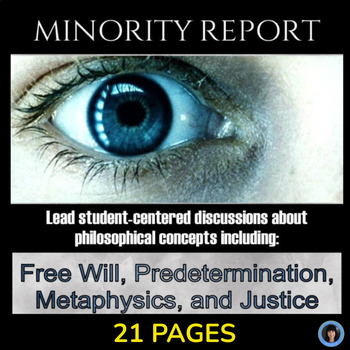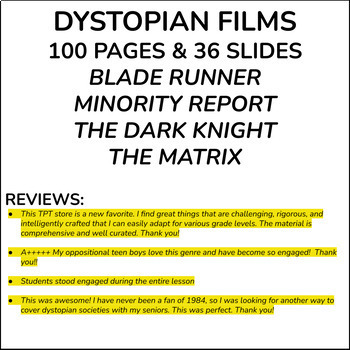Film studies philosophy and film study high school movie guide dystopian films
- Zip
- Google Apps™

Products in this Bundle (4)
Description
TOP REVIEW: This TPT store is a new favorite. I find great things that are challenging, rigorous, and intelligently crafted that I can easily adapt for various grade levels. The material is comprehensive and well curated. Thank you!
I use films to introduce students to philosophy. I put a copy of the film in the library on reserve, and my students can take it out for four hours at a time. They watch the film on their own time as a form of homework (one they usually enjoy).
OVER 40% discount.
1. The Dark Knight
2. Blade Runner
3. The Matrix
4. Minority Report
This product is OVER 100 PAGES and 36 SLIDES!! 30% Discount!
1. The Dark Knight
THIS FILM IS ABOUT TERRORISM, DUTY, AND BEING A HERO.
THE DARK KNIGHT is an excellent film to use when studying philosophical concepts including, but not limited to, the following: morality, ethics, sacrifice, duty, freedom, and fairness.
THIS FILM IS ABOUT TERRORISM, DUTY, AND BEING A HERO.
Even if you don’t know the film, chances are your students do. It is surprisingly sophisticated and the dialogue is interesting and provocative. The film helps students understand terrorism and sacrifice.
Most students enjoy talking about films so this is a great way to raise difficult philosophical issues. The included questions tackle topics related to heroism, terrorism, morality, and fairness (just to name a few).
Some of the questions use quotations from the film.
INCLUDED IN THIS PRODUCT ARE THE FOLLOWING:
♞ SEVEN STUDENT QUESTIONS with 13 sub-questions (There are three short scenes from the film – each quotation is followed by three questions – and there are four additional questions.) THESE QUESTIONS ARE ALSO IN GOOGLE SLIDES!
♞ Critical Lens Quotation Practice using a quotation from the film (includes an excerpt from the screenplay.)
♞ Two more excerpts from the screenplay along with five questions that refer back to the excerpts. THESE QUESTIONS ARE ALSO IN GOOGLE SLIDES!
♞ 14 GENERIC TEMPLATES - PRINT ONLY. THESE TEMPLATES HAVE THE DARK KNIGHT WRITTEN ON THE BOTTOM OF THE PAGE BUT COULD BE USED FOR ANY OF THE FILMS IN THIS BUNDLE!!!
♞ This product allows for differentiated learning; some students may be more comfortable with the questions that focus on the lower levels of Bloom’s Taxonomy (remembering/comprehension and simple applications/understanding), whereas other questions provide students the opportunity to focus on higher levels (analysis and evaluation).
♞ There is a link that you share with your students to use interactively through Classroom™ or other online programs.
♞ Editable instructions for students when using the interactive version.
♞ Information on Google Slides™ for teachers and students.
2. BLADE RUNNER | BLADE RUNNER FILM STUDY
BLADE RUNNER is an excellent film to use when studying philosophical concepts including, but not limited to, the following: morality, ethics, sacrifice, duty, knowledge, and postmodernism.
INCLUDED IN THIS PRODUCT ARE THE FOLLOWING:
☤JUST ADDED 17 GOOGLE SLIDES! These slides contain the same questions as below, and there are three extra slides – see the preview for more information.
☤18 LONG ANSWER, SHORT ANSWER, and/or DISCUSSION QUESTIONS (print and google slides).
☤FIVE quotations from the film for analysis (print and google slides).
☤A TEST with 17 multiple choice questions and answers (print only).
☤This product allows for differentiated learning; some students may be more comfortable with the questions that focus on the lower levels of Bloom’s Taxonomy (remembering/comprehension and simple applications/understanding), whereas other questions provide students the opportunity to focus on higher levels (analysis and evaluation).
☤There is a link that you share with your students to use interactively through Classroom™ or other online programs.
☤Editable instructions for students when using the interactive version.
☤Information on Google Slides™ for teachers and students.
3. The Matrix
I use films as a way to introduce students to philosophy. I put a copy of the film in the library on reserve and my students are able to take the copy out for four hours at a time; they watch the film on their own time as a form of homework (one they usually enjoy). Students love talking about movies.
INCLUDED IN THIS PRODUCT ARE THE FOLLOWING:
➢ A multiple-choice test (for the first film only) with 15 questions and answers.
➢ Five pages of student-centered discussion questions - several may be used as essay questions.
➢ The zip file contains the test and questions as separate PDF
I have found that discussing films is a successful way to engage my students; most students get involved, even the shy ones, because almost all teenagers find it easy to talk about films, so they usually have something to say.
TEACHER TIP:
You don’t need to show entire films, just short clips of these films, to develop competencies deemed essential in the new CCSS guidelines.
I teach THE MATRIX as a TEXTURE TEXT or a CONTEXT TEXT usually alongside THE REPUBLIC. It is an excellent film to use when studying philosophical concepts including, but not limited to, the following: knowledge, existence, sacrifice, and metaphysics.
4. Minority Report
I use films as a way to introduce students to philosophy. I put a copy of the film in the library on reserve and my students are able to take the copy out for four hours at a time; they watch the film on their own time as a form of homework (one they usually enjoy). Students love talking about movies; this one has a great cast and is directed by Steven Spielberg.
INCLUDED IN THIS PRODUCT ARE THE FOLLOWING:
This product has been completely redone to include teacher notes! It is now 20 pages.
- A multiple-choice test (based upon the included reading) with 15 questions and answers. This is included as a separate PDF file.
- Five discussion questions - with several sub-questions – for a total of 17 questions. Some of the questions are quite complicated whereas others are very straightforward.
- There are two options for the questions:
- listed over two pages
- including images and on separate pages
- Two pages of the screenplay to be analyzed
- Five pages of teacher notes
I have found that discussing films is a successful way to engage my students; most students get involved, even the shy ones, because almost all teenagers find it easy to talk about films, so they usually have something to say.
Minority Report is an excellent film to use when studying philosophical concepts including, but not limited to, the following: free will, predetermination, metaphysics, duty, and justice. It also raises interesting questions about the difference between fact and opinion.
TEACHER TIP:
You don’t need to show entire films, just short clips of these films, to develop competencies deemed essential in the new CCSS guidelines.
Customer Tips:
How to get TPT credit to use on future purchases:
• Please go to your My Purchases page (you may need to login). Beside each purchase, you'll see a Provide Feedback button. Simply click it and you will be taken to a page where you can give a quick rating and leave a short comment for the product. I value your feedback greatly as it helps me determine which products are most valuable for your classroom so I can create more for you.
❤️ Click HERE to become a follower. You will now receive customized email updates about this store.
Copyright © jellycat-in-the-snow productions
All rights reserved by author Permission to copy for single classroom use only Electronic distribution limited to single classroom use only
Please remember that any of the products that you download from my store are my copyrighted property and licensed only for you to share with your direct students. If another teacher wants to use these same products, they will need to purchase them directly from my TpT store, or you may purchase an additional license for them. None of my products may be shared online. Posting of my copyrighted materials may happen only in a password-protected environment, such as Google Classroom, and accessed only by your students. Posting on public websites (WordPress, Blogger, Facebook Groups, etc.) is strictly prohibited.





